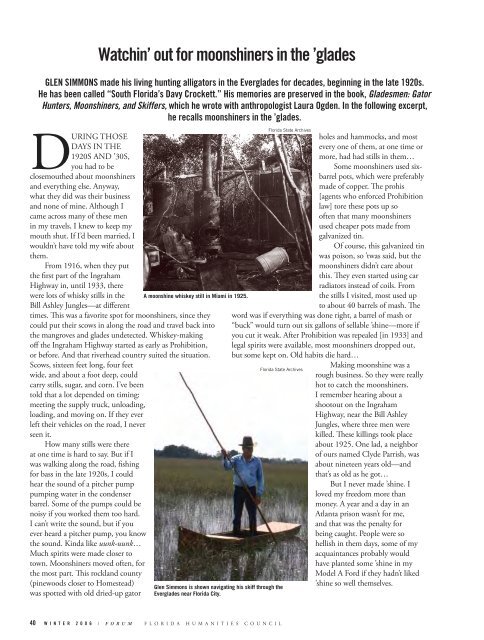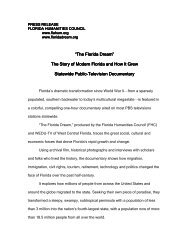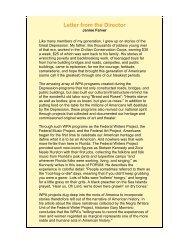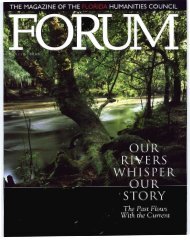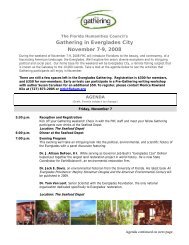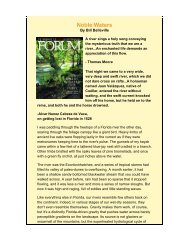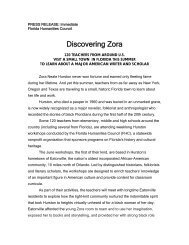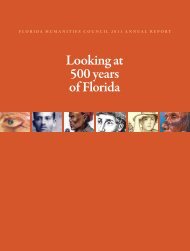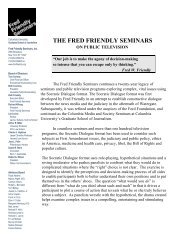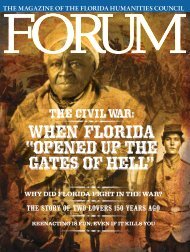THE MAGAZINE OF THE FLORIDA HUMANITIES COUNCIL
THE MAGAZINE OF THE FLORIDA HUMANITIES COUNCIL
THE MAGAZINE OF THE FLORIDA HUMANITIES COUNCIL
You also want an ePaper? Increase the reach of your titles
YUMPU automatically turns print PDFs into web optimized ePapers that Google loves.
DURING THOSE<br />
DAYS IN <strong>THE</strong><br />
1920S AND ’30S,<br />
you had to be<br />
closemouthed about moonshiners<br />
and everything else. Anyway,<br />
what they did was their business<br />
and none of mine. Although I<br />
came across many of these men<br />
in my travels, I knew to keep my<br />
mouth shut. If I’d been married, I<br />
wouldn’t have told my wife about<br />
them.<br />
From 1916, when they put<br />
the first part of the Ingraham<br />
Highway in, until 1933, there<br />
were lots of whisky stills in the<br />
Bill Ashley Jungles—at different<br />
times. This was a favorite spot for moonshiners, since they<br />
could put their scows in along the road and travel back into<br />
the mangroves and glades undetected. Whiskey-making<br />
off the Ingraham Highway started as early as Prohibition,<br />
or before. And that riverhead country suited the situation.<br />
Scows, sixteen feet long, four feet<br />
wide, and about a foot deep, could<br />
carry stills, sugar, and corn. I’ve been<br />
told that a lot depended on timing:<br />
meeting the supply truck, unloading,<br />
loading, and moving on. If they ever<br />
left their vehicles on the road, I never<br />
seen it.<br />
How many stills were there<br />
at one time is hard to say. But if I<br />
was walking along the road, fishing<br />
for bass in the late 1920s, I could<br />
hear the sound of a pitcher pump<br />
pumping water in the condenser<br />
barrel. Some of the pumps could be<br />
noisy if you worked them too hard.<br />
I can’t write the sound, but if you<br />
ever heard a pitcher pump, you know<br />
the sound. Kinda like uunk-uunk…<br />
Much spirits were made closer to<br />
town. Moonshiners moved often, for<br />
the most part. This rockland county<br />
(pinewoods closer to Homestead)<br />
was spotted with old dried-up gator<br />
Watchin’ out for moonshiners in the ’glades<br />
GLEN SIMMONS made his living hunting alligators in the Everglades for decades, beginning in the late 1920s.<br />
He has been called “South Florida’s Davy Crockett.” His memories are preserved in the book, Gladesmen: Gator<br />
Hunters, Moonshiners, and Skiffers, which he wrote with anthropologist Laura Ogden. In the following excerpt,<br />
he recalls moonshiners in the ’glades.<br />
A moonshine whiskey still in Miami in 1925.<br />
holes and hammocks, and most<br />
every one of them, at one time or<br />
more, had had stills in them…<br />
Some moonshiners used sixbarrel<br />
pots, which were preferably<br />
made of copper. The prohis<br />
[agents who enforced Prohibition<br />
law] tore these pots up so<br />
often that many moonshiners<br />
used cheaper pots made from<br />
galvanized tin.<br />
Of course, this galvanized tin<br />
was poison, so ’twas said, but the<br />
moonshiners didn’t care about<br />
this. They even started using car<br />
radiators instead of coils. From<br />
the stills I visited, most used up<br />
to about 40 barrels of mash. The<br />
word was if everything was done right, a barrel of mash or<br />
“buck” would turn out six gallons of sellable ’shine—more if<br />
you cut it weak. After Prohibition was repealed [in 1933] and<br />
legal spirits were available, most moonshiners dropped out,<br />
but some kept on. Old habits die hard…<br />
Florida State Archives<br />
Glen Simmons is shown navigating his skiff through the<br />
Everglades near Florida City.<br />
40 W I N T E R 2 0 0 6 / F O R U M F L O R I D A H U M A N I T I E S C O U N C I L<br />
Florida State Archives<br />
Making moonshine was a<br />
rough business. So they were really<br />
hot to catch the moonshiners.<br />
I remember hearing about a<br />
shootout on the Ingraham<br />
Highway, near the Bill Ashley<br />
Jungles, where three men were<br />
killed. These killings took place<br />
about 1925. One lad, a neighbor<br />
of ours named Clyde Parrish, was<br />
about nineteen years old—and<br />
that’s as old as he got…<br />
But I never made ’shine. I<br />
loved my freedom more than<br />
money. A year and a day in an<br />
Atlanta prison wasn’t for me,<br />
and that was the penalty for<br />
being caught. People were so<br />
hellish in them days, some of my<br />
acquaintances probably would<br />
have planted some ’shine in my<br />
Model A Ford if they hadn’t liked<br />
’shine so well themselves.


